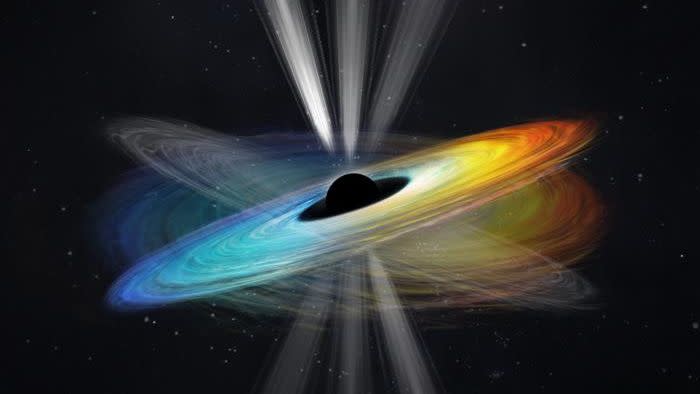Researchers Have Finally Confirmed That Black Holes Spin

"Hearst Magazines and Yahoo may earn commission or revenue on some items through these links."
Researchers have finally confirmed that black holes spin.
By watching the radio jet of the black hole at the center of the galaxy Messier 87, researchers were able to watch it tilt, a movement that confirms the black hole’s spin.
The jet is likely produced by the fact that the accretion disk around the black hole doesn’t spin as fast as the black hole itself.
A lot about black holes, we currently take on faith—and on very, very complicated math. But because we are so new to actually being able to clearly look at these things directly with a telescope, there’s a lot about them that we’re pretty sure we know, but have yet to confirm.
Well, recently, researchers got to confirm one of the most basic tenants we have about black holes—they spin. Using over two decades worth of of data on the black hole at the center of the galaxy Messier 87 (also known as M87), the black hole that was the subject of our first-ever black hole photograph back in 2019, researchers were able to confirm once and for all that black holes do indeed spin as predicted by Einstein’s General Theory of Relativity. The study containing these findings was recently published in the journal Nature.
“After the success of black hole imaging in this galaxy with the [Event Horizon Telescope], whether this black hole is spinning or not has been a central concern among scientists,” Kazuhiro Hada, one of the authors on this study, said in a press release. “Now anticipation has turned into certainty. This monster black hole is indeed spinning.”
Central to this discovery were the black hole’s radio jets—powerful beams of radio-wavelength energy emanating from the shadow at the centers of these gravity wells. Contrary to the way we usually think about black holes as exclusively star-devouring gravity wells, they are plenty capable of expelling energy as well as consuming it.
For a long time, it has been believed that these jets were powered by the spinning of the black holes themselves. But it’s not very easy to watch a black hole spin, and as such, we’ve long been missing the proof we need to put a pin in this proclamation. So, in order to get that proof, scientists went to work.
After observing this black hole for 23 years and keeping careful track of its jet, it was confirmed that the jet oscillates with an amplitude of 10 degrees—clear evidence that the black hole was spinning, and that the spin was hauling the jet out of alignment on a regular basis.
But why does this happen? Why does the spinning of a black hole have any effect on the jet at all, and what causes the jet in the first place? It turns out that it most likely has something to do with the accretion disk—the large spinning mass of glowing stars and debris surrounding the black hole itself
If the black hole is spinning, it drags all of spacetime behind it in a phenomenon known as “frame dragging.” But it can’t drag everything at the same rate. According to the study authors, the black hole itself spins faster than the accretion disk, and this misalignment is what creates the jet.
“We are thrilled by this significant finding,” CUI Yuzhu, lead author on the study, said in the press release. “Since the misalignment between the black hole and the disk is relatively small and the precession period is around 11 years, accumulating high-resolution data tracing M87’s structure over two decades and thorough analysis are essential to obtain this achievement.”
And what an achievement it is. There’s still a lot more work to do for us to truly understand the inner workings of a black hole, but this is a very important puzzle piece to have finally been able to fit into place.
You Might Also Like

